Call Us
+86 136 6007 9809
Call Us
+86 136 6007 9809
Oct. 26, 2023
Fasteners are the main components to realize the installation and assembly of automotive parts, and the application study of fasteners in sheet metal connection can further understand the way of automotive design connection.
Through analyzing automotive sheet metal connection requirements, Different types of fasteners for application research and example analysis. Factors of lightweight automobiles: The current automobile uses many high-strength steel plates, and specific designs also use aluminum alloy plates to further reduce the entire vehicle's weight. Therefore, sheet metal connections in automobile production and assembly occupy a large proportion, such as the welding of automobile body-in-white, the connection of body parts, and the installation of body interior parts. Using fasteners to connect sheet metal is the primary connection method in automobile production other than welding. Due to the variety and huge number of fasteners for automobiles, it is necessary to study the Application of fasteners in automobile sheet metal connections.
The fastener types should be selected first in the connection design, and the specific specifications and parameters should be chosen after calculation and proofreading. Starting from analyzing the types and characteristics of automotive sheet metal, according to the connection structure and requirements applicable to different fasteners, and by comparing and analyzing the fasteners mainly used in the current automotive industry, the study on the selection of fastener types in sheet metal connection will help to improve the level of automotive development and design.
一、Requirements for fastener connection
1. Sheet metal materials: high-strength steel plates in automobile applications tend to increase; it solves the contradiction between the weight and strength of the car's ordinary plate. High-strength steel plate is generally stamping molding, often as the main structural parts of the body, for the body-in-white stage before a variety of molding and connecting, more welding. Still, the carbon alloying elements' content will affect the steel plate's weldability and welding parameters and processes must be adjusted before welding. The Application of ordinary galvanized steel is more common; the tensile strength of the steel plate is less than high-strength steel, and punching, bending, molding, and other processing is relatively easy. Zinc resistance is more significant, affecting the welding characteristics of steel. When choosing fasteners for connection, Generally avoid using welded bolts or nuts to connect high-strength and galvanized steel plates.
The Application of aluminum alloy plates is mainly given its lightweight; the car has non-important bearing parts instead of steel plate, and aluminum alloy welding characteristics are inferior, so more fasteners are used to connect.
2. Connection strength and performance: automotive sheet metal connection strength and performance to meet the requirements of the connection part involving body safety, collision protection, and pedestrian protection parts should be tested and verified to ensure that the connection effect meets the design requirements. Such as door hinges and body sheet metal connections generally use double screws with welded nuts to ensure that the door in the vehicle collision or rollover effectively protects the occupants, and in the event of an accident, the connection parts are not easy to deform, the occupants can escape smoothly.
Connection strength design and selection is to ensure the reliability of the premise of the connection in the use of threaded connections by controlling the preload to prevent loosening of the threaded coupling; it is necessary to ensure the accuracy of the calculations and analysis of the data, the preload is too large to lead to the use of fasteners in the fracture of the failure or destruction of the parts to be connected to the connection loosening, on the contrary, the preload is too small will produce a clamping force is insufficient to secure the connecting part with the connection of friction to become smaller, to create loosening. Loosening.
3. Connection process: Automobiles have a high degree of assembly line operation production, and the choice of connection process should consider production rhythm and resource allocation. Such as parts connected to the body, usually used in the body welding during the welding nuts or welding bolts, to the assembly stage and then assembly to improve the assembly efficiency and ensure the accuracy of the installation. Selection of the connection process should be considered to avoid potential corrosion generated by the superimposed connection of different types of sheet metal. The connection process will also affect the production cost, and the rational choice of fasteners can reduce unnecessary processes and operations.
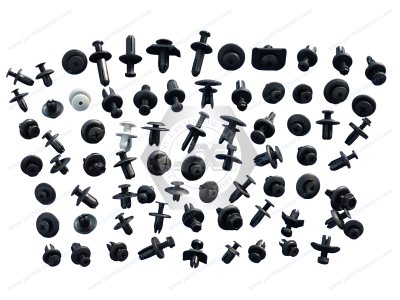
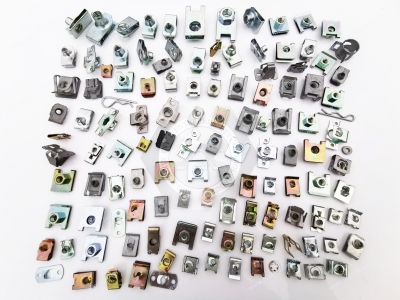
二、 Application of fasteners: Connections with standard threaded fastenings
1. Connections without nuts. If the thickness of the parts connected with the sheet metal is large or can only make blind holes, you can use bolts or screws screwed directly into the tightening; due to the thickness of the sheet metal being small, applying the tightening torque when the sheet metal is easy to produce deformation, and thus can not be reliably clamped to the sheet metal, resulting in loosening of the threads or the connection surface of the connected parts of the concave, the form of the connection is relatively simple but insufficient reliability.
2. Connection with ordinary nuts. The use of regular bolts with the connection is more common, mainly used for sheet metal and other parts of the connection; the thickness of the connection should not be too thin, and the requirements of the connected parts on both sides of a certain amount of wrenching space, the form of connection assembly efficiency is slightly lower. Welded bolts (Figure 1) or welded studs can also be used; the first bolt or stud is fused to the sheet metal, then installed to be connected, and finally fixed with an ordinary nut; this connection is simple to operate, easy to assemble, can be unilateral connection. In connection with everyday nut fit, the thin metal plate still cannot be clamped, resulting in the problem of connection reliability.
3. Match the connection with the nut fixed on the sheet metal. The nut is set on the sheet metal first and then directly connected with the bolt or screw in the assembly, which improves the connection efficiency and reduces the chance of thread loosening—fixed in the sheet metal nut on the type and method of more, usually welded nuts, riveted nuts, stamped nuts, reed nuts, and embedded plastic nuts (Figure 2).
Welded nuts and welded bolts are to consider the weldability of the sheet metal and welding process; welding strength is higher, and the assembly should be avoided when the sheet metal deforms. Welding is easy to produce welding slag and exhaust, as far as possible. Do not use manual welding. Rivet nuts require special installation tools and sheet metal prefabricated holes; ordinary rivet nut prefabricated holes for round holes, hexagonal rivet nut prefabricated holes for hexagonal, and hexagonal tube body rivet nuts can better prevent their rotation. A stamping nut is not required to prefabricate holes but directly in the sheet metal punched out of round holes. The use of a nut punch partially embedded in the sheet metal to achieve fixed, high production efficiency and reliable connection, but the cost of equipment investment is also high, so the use of the nut should be assessed before the production efficiency and the production batch, the relationship between the cost of equipment investment. Reed nut is more straightforward to use, though the reed is clamped on the thin metal plate. Its positioning accuracy is poor and commonly used in license plates and other non-important connection parts. Inserted plastic nuts and plastic with self-tapping screws to match the use of self-tapping screws through the insertion and extrusion of plastic, the use of nut expansion clamped to the thin metal plate; the connection strength is lower, can be used for non-metallic plates and decorative parts of the fixed.
4. Using the ordinary threaded connection to consider the thread anti-loosening generally can be used for pre-tensioning force control and pre-coating locking Loctite adhesive two ways.
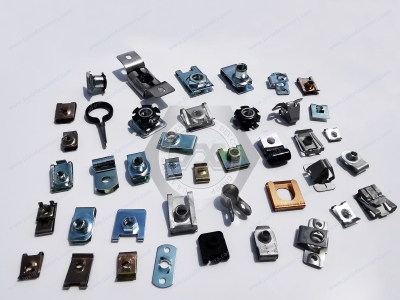
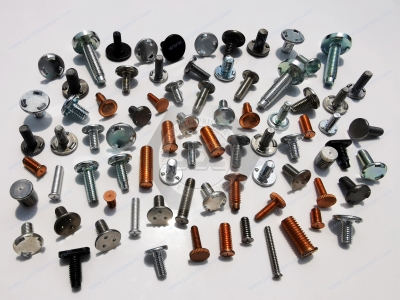
三、Fastening connections with self-tapping screws
Self-tapping screws are often used for connections between metallic and non-metallic sheet metal parts, but their connection strength is small. Due to the influence of the thread on the plate gap during the connection process, it is best to connect no more than four layers of plates. The use of self-tapping screws should be made in advance of the light hole. If the operating environment is inconvenient, you can use self-drilling self-tapping screws, eliminating the step of prefabrication of blond holes, to improve the efficiency of the single connection, but does not adapt to mass production, self-drilling self-tapping screws screwed into a large number of Noise, is not conducive to the operating environment for the protection of the operator.
Self-tapping screws for plastics compared to self-tapping screws, efficiency, and installation methods are similar; all need to be prefabricated.
The system is similar to self-tapping screws in terms of performance and installation, both need to be prefabricated holes, but the plastic parts of the self-tapping screw thread type are different from the ordinary self-tapping screws but present.
High and low staggered, conducive to clamping plastic parts, embedded in the plastic body depth is significant and should not be loosened.
四、Fastened connections with riveted metal panels
Riveting is suitable for connecting large metal coverings that are not removable. Compared with the use of threaded fasteners connection, riveting is more economical and lighter weight. The riveting process is easier to control and has no adverse effect on the mechanical properties of the materials to be joined. Riveted plate holes on the connected parts of the cross-sectional strength will cause some weakening, and the riveting fastening force is small. Therefore, the tightness of riveted joints is less than welding, and fatigue resistance is also poor, so rivet groups or increasing the density of riveting are usually used to meet strength and fatigue requirements.
The limitations of riveting are that it is not suitable for connecting too thick material; the riveted parts should not be more than four layers, mainly to withstand shear force, and it is not applicable to withstand a sizeable tensile force, commonly used in the non-tensile structure of the fixed connection. In addition, it should also be noted that the riveted parts of high strength parts should not be sandwiched between the parts of low strength; the thickness and rigidity of the parts should be arranged on the outside. When the material to be connected is softer, Such as rivets for plastics can be used.
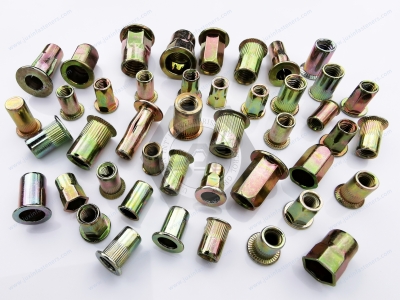
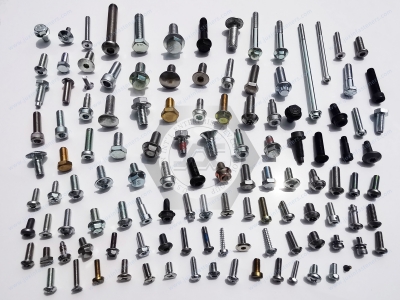
五、Fastening with plastic clips
Metal sheet connecting interior trim or lightweight parts can be used for plastic snap connections (Figure 3), such as the body of the side of the body and other plastic decorative parts of the connection. Snap is not conductive, not easy to corrode, has low thermal conductivity, is non-magnetic, and can meet the connection strength on relatively small occasions. Because of the simple structure of the buckle, the material and processing price are low and can be mass-produced and widely used.
Conclusion
Although the ordinary threaded connection is widely used, there are requirements for threaded anti-loosening. Threaded connection sub-bearing capacity, but not all can effectively play the role of bearing.
The use of specialized parts should pay attention to cost and scale efficiency, and the Application of plastic parts is gradually expanding. Automotive sheet connection technology and the Application of fasteners are essential components of automotive design and manufacturing; sheet metal material strength, density, electrical conductivity, and other characteristics will impact the connection. Therefore, a reasonable choice of standard parts is the first link in the sheet metal connection. The connection's quality also affects the final automotive product's reliability and durability.
If you are looking for high-quality fastener screws & all kinds of No-Slip Clip-On Barrel Nuts or technical support for structural design, please get in touch with me.adelajonly@gmail.com. Thanks.
Website: www.juxinfasteners.com
Previous: Commonly used surface treatment process for fasteners
Next: Who We Are
Contact Us
Tel.:
+86 020 8621 0320
+86 020 3121 6067
Technical Support:
Navigation
SEND INQUIREY